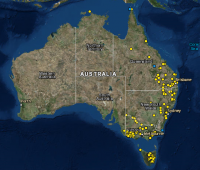A new map recording the massacres of Aboriginal clans across the east coast of Australia, also known as the colonial frontier, has been constructed by researchers of the University of Newcastle. With more than 150 sites recorded, the map provides new insights into the scope of the massacres that occurred following the arrival of the First Fleet bringing convicts, as well as providing closure to Indigenous people from respective clans. Researchers say that they intend to add to the map over time as they continue to collate the oral histories of Indigenous people with settler accounts told through newspapers, court documents and letters.
"As we move further west, I think we'll find that map is going to have a lot of dots on it," said Professor Lyndall Ryan from the University.
The first site analysed by the researchers was Tasmania, where the Black War took place. As settlers migrated north along the mainland, the massacres continued to escalate.
"We've got a number of really major massacres where 60 or more [people] were killed and then we've got a very major event at Gippsland, the Warrigal Creek massacres, where over a period of about five days, about 150 people were killed," Ryan said.
The yellow dots on the map mark the number of people killed, the date and the kind of weapons used by the settlers.
However, many Indigenous people requested that the exact location of these massacres not be recorded, so the pinpoints mark an approximate location instead.
In addition to the new insights yielded by the map, Ryan said she hopes the map will overturn any assumptions that were made for generations that this land wasn’t fought for by the first peoples.
“If you can provide the evidence of the information, then it could help to overcome a lot of the uncertainty and skepticism," she said.
Professor Ryan said many Aboriginal people had contacted her with further details of massacres.
She said finding sources to corroborate oral
history of the massacres was difficult, because the killings were “designed
not to be discovered”.
Many artists have depicted the massacres in their works, including Judy Watson's "a picnic with the
natives – the gulf".
It includes a series of canvases showing dots on the map depicting
massacre sites across the country.
Sites in Tasmania, Victoria and most sites in New South Wales and Queensland have been recorded, but Professor Ryan said much more work needed to done in other states.
Related references:
Mapping
Aboriginal massacres makes it time to recognise the colonial wars, say leading
historians - 'Almost every Aboriginal clan experienced massacres at the hands of early
settlers in the "colonial wars", according to the first stage of a
new online mapping project.' Professor
Ryan and Tasmanian author Professor
Henry Reynolds – whose books documented the "forgotten"
and "silent" colonial wars against Aboriginal people – said it was
time for the Australian
War Memorial to recognise this war.
"By the time the project is completed in several years, she expects it
will find that nearly 15,000 people were killed in massacres (defined as where
six people or more died). This doesn't include smaller attacks,
which have been estimated by some academics to bring the death toll to more
than 30,000 from 1788 until the 1940s."
Untold
history of Australia, painted in blood - 'Research based on colonial or settler
accounts and Indigenous oral
history mark the thousands of first
nations people killed by Europeans in frontier wars.'
"The first recorded killing happened on 1 September 1794, six years after
the First Fleet arrived in Sydney Cove and declared Australia a British colony.
"It was not the first murder of Aboriginal
people by Europeans
but it is the earliest to have enough evidence to meet the strict criteria of
University of Newcastle researchers, who have mapped the sites of more than 150
massacres in one of the most significant pieces of work ever undertaken on the
frontier wars."
Australian
Frontier Conflicts - The
Australian Frontier Conflicts website
is a project long in the making which had its genesis when the author, Jane Morrison, became involved in the Aboriginal justice movement around
1971.
The information it provides is aimed at pointing those interested in
Australia’s frontier conflict history to resources for further study and
research. It is particularly aimed at senior high school and tertiary students
and anyone interested in Australian history from 1770.
Resources cited focus on conflicts, beginning with the permanent arrival of the
British in 1788 to set up the colony of New South Wales, until the 1940s.
The site is extremely comprehensive, recording many killings and massacres of
Aboriginal people up until 1941. Well done Jane!
An
understudied area - #FrontierWars - #FrontierConflicts - #ColonialWars - #AboriginalHistory - #Massacres - #AboriginalMassacres - #ColonialFrontier - #AboriginalSovereignty - #SovereigntyNeverCeded - #AboriginalTalk - Videos by Eleanor Gilbert of
Enlightning Productions: Moving Cenotaph: frontier
wars & massacres ('The Frontier Wars
Commemorative March is our way of saying our Old People, who died defending
their lands and freedoms, must also be remembered.'); https://www.youtube.com/watch?v=iYmKUQJd3TA;
http://www.sovereignunion.mobi/content/moving-cenotaph-frontier-conflicts; https://groups.google.com/forum/#!forum/wgar-news - First formal acknowledgement of First Nations people in
the Australian Defence Force - Moving
Truth: 6 years of Frontier Wars marches on Anzac Day - Smallpox:
1789 biological warfare against First Nations - Book
“Blood on the Wattle”


